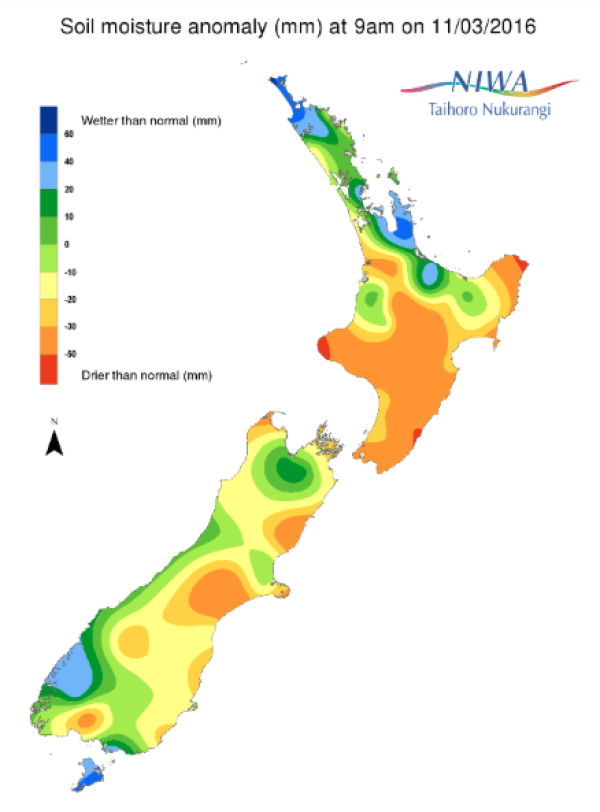A weekly update describing soil moisture across the country to help assess whether severely to extremely dry conditions are occurring or imminent. Regions experiencing these soil moisture deficits are deemed “hotspots”. Persistent hotspot regions have the potential to develop into drought.
Soil Moisture
Across the North Island, soil moisture levels have generally decreased when compared to this time last week. The most substantial decreases were observed in Taranaki and western Waikato. Steady decreases continued across much of Manawatu-Whanganui, southern Hawke’s Bay, and Wellington-Wairarapa. The driest soils compared to normal for this time of the year are found in southern Taranaki and near the border of Masterton and Tararua.
Across the South Island, soil moisture levels have mainly decreased. The most dramatic decreases were found in far northern Tasman, central and southern Canterbury, northwestern Otago, and central Southland. The driest soils compared to normal for this time of the year are found in coastal Hurunui, Ashburton, Timaru, and central Southland.
Outlook
After a week that featured below normal precipitation across a majority of the North Island, the weekend will have generally dry conditions with strong high pressure overhead. The next chance for rain will occur on Sunday night and Monday as a disturbance pushes from the Tasman across the central North Island. Patchy rainfall will continue in the same areas on Tuesday, with two-day rainfall between 5 and 15 mm. Showers may expand to include the northern North Island on Tuesday. A cold front is forecast to push north from Wednesday into Thursday, possibly giving the southern and central North Island appreciable falls depending on its speed. There is some uncertainty in the late-week period, though the most likely outcome is for high pressure to build to the east of the North Island and allow some drying; however, there is still some chance that showery weather persists on Friday. The heaviest rainfall over the next week is forecast to be across the Central Plateau, with weekly amounts likely nearing or exceeding 25 mm. Less rain is likely across the eastern and far northwestern North Island, with some places seeing weekly amounts below 10 mm.
After a generally dry Friday across the South Island, rain will return to the West Coast and Fiordland on Saturday. Daily falls will be mostly less than 10 mm. Rain will continue across the aforementioned regions on Sunday while expanding eastward to include the rest of Southland and parts of Otago. Falls will be highest in Fiordland and the southern West Coast, with up to 15 mm expected; elsewhere, less than 5 mm are forecast on Sunday. The unsettled pattern will persist across the southern South Island on Monday before rain expands northward on Tuesday and continues across the far northern part of the island on Wednesday. Appreciable falls of 10-15 mm with locally higher amounts are possible for the east coast. Organised rainfall will likely push north of the South Island later Wednesday or on Thursday. A low over the Tasman may approach late in the week (Friday night and Saturday), possibly directing heavy rainfall from the north.
Soil Moisture
For the North Island, hotspot areas remain present in southern and western Hawke’s Bay, much of Wellington-Wairarapa, Manawatu-Whanganui, southeastern Taranaki, and northeast coastal Gisborne. Hotspot activity has expanded across central and northern Taranaki with a new hotspot in western and central Waikato and far northeastern Bay of Plenty. Periods of rainfall especially across the central North Island may work to reduce hotspot activity there over the next week. Elsewhere, hotspots may remain about the same or reduce in size slightly. However, a hotspot may develop over southwestern Northland and expand in Gisborne and the eastern Bay of Plenty.
On the South Island, hotspot areas across central and northern Canterbury remain present. Hotspot activity in Otago has expanded to include a small area in northeastern Queenstown Lakes. A small, new hotspot area has developed in far northern Marlborough. Over the next week, hotspot activity is forecast to remain the same or worsen for parts of the east coast and northern South Island. Periods of rain across the far south and West Coast through the week will prevent new hotspot development there.
NB: due to the timing and reporting of daily 24 hour rainfall amounts (9 am each day) and time required to compute soil moisture deficit values, the rain that occurred on Friday 11 March will not be fully reflected in the soil moisture anomaly maps until Saturday 12 March.
Background
Hotspot Watch a weekly advisory service for New Zealand media. It provides soil moisture and precipitation measurements around the country to help assess whether extremely dry conditions are imminent.
Soil moisture deficit
Soil moisture deficit is the amount of water needed to bring the soil moisture content back to field capacity, which is the maximum amount of water the soil can hold.
Soil moisture anomaly
This is the difference between the historical normal soil moisture deficit (or surplus) for a given time of year and actual soil moisture deficits.
Definitions
“Extremely” and “severely” dry soils are based on a combination of the current soil moisture status and the difference from normal soil moisture (see soil moisture maps at https://www.niwa.co.nz/climate/nz-drought-monitor/droughtindicatormaps).
Soil moisture maps
Pictured below are soil Moisture Anomaly Maps, relative to this time of year. The maps show soil moisture anomaly for the past two weeks.


